冻土区建筑空间通风壳式基础的实验研究
2014-03-19GoncharovPetrova
Goncharov Y.M.,Petrova Y.M.
(西伯利亚联邦大学 土木工程学院,克拉斯诺亚尔斯克 660041,俄罗斯)
0 Introduction
The problem of increasinsg the service life of concrete and reinforced concrete structures is one of the most important tasks in the construction of buildings and structures in permafrost zone.First of all,it concerns the foundation structures,working in a layer of seasonal thawing-freezing soil under thebuilding.Complex thermal,physical and chemical effects of the environment,acting on the structure in combination with operating loads may be the cause of irreversible deformation-destruction of the concrete.The aforementioned has become the basis for the development and investigation of surface spatial ventilated foundations on the intermediate layer underlined by frozen soil,which allows to completely eliminate overwetting of foundation material in the buildings operation.
In view of the essential novelty of shell-type foundation structure and necessity of the conditions of its work in the presence at the base of permafrost soil,the goal was set-to carry out the experimental investigations of various models and the natural fragment of foundation.
For experimental research the objectives were set:
1)To identify a qualitative picture of the stressstrain state(SSS)of structures in the elastic stage and in the brittle fracture stage depending on deformation phases of the base;
2)To identify the nature of the distribution and magnitude of the forces in structural elements of the shell-type foundation.
3)To determine the node strength of foundation folds in places of transition of the horizontal beam (Fig.1c)of an element into a thin-walled inclined plate,as well as its transition to a horizontal plate resting on the foundation soil.
4)To determine the effect of vertical reinforcing ribs in the elements of the folds on the spatial rigidity of shell-type foundation.
The fine-grained concrete models were manufactured and tested for research of the shell-type foundation according to the tasks considering the actual material properties of structures,based on the theory of extended similarity of the solid deformed bodies according to the following techniques[1-3].
1 Constructive solutions of the shelltype foundations
From what has been said the new direction in foundation engineering implementing the concept of loads transfer and deformation from spatial ventilated shell-type foundation,combining the functions of bearing structures and frozen device ground through the intermediate layer resting on the frozen ground was proposed,investigated and experimentally tested in longterm construction and operation of buildings in permafrost zone in Igarka and Norilsk.
The intermediate layer from nonfrost-susceptible material(sand,semi-gravel sandy soil,rock)contributes to a significant reduction in the intensity of cryogenic processes in thermal and mechanical effect of buildings with frozen soils.
Structure of spatial foundation“AC 670682 CCCP МКИЕ 02.27/02”(Fig.1)is performed in the precast-monolithic and monolithic variations.Between the inclined plates in the internal and if necessary in the external foundation spaces,depending on the number of storeys and structural scheme of the building,the reinforcing ribs are located.The internal foundation spaces are filled with a low strength material.The jointing of prefabricated elements of the foundation is accomplished with the help of the armature outcome and joints monolithing.The combination of the upper foundation spaces with floor slabs creates the trapezoidal canals for running the cold air through the foundation due to wind and heat pressure while maintaining the frozen state of the foundation soil(Fig.1a).Thickness of inclined and horizontal plates of the shell-type foundation is taken depending on the actual loads-160~250 mm.
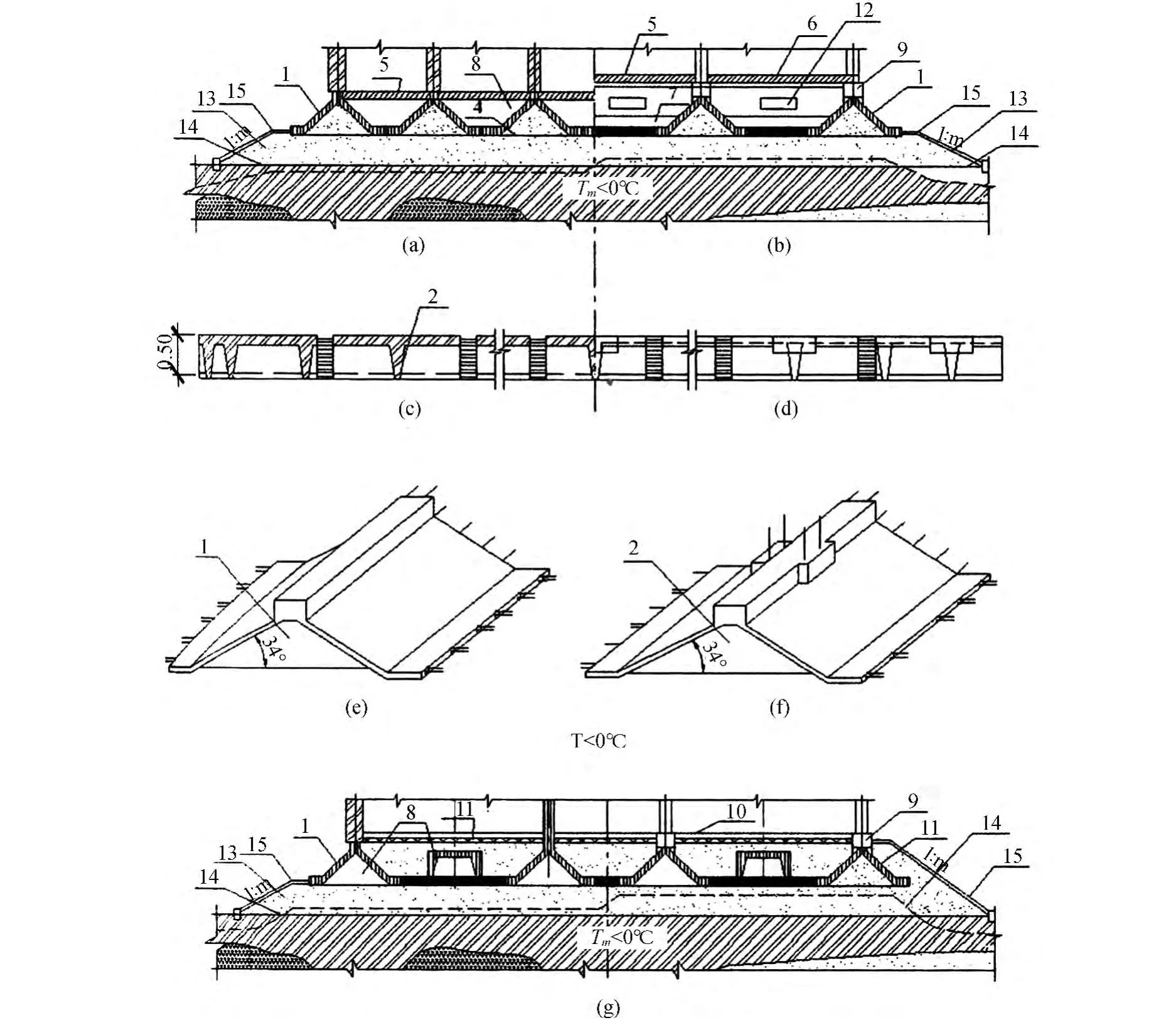
Fig.1 The scheme of the structural decision of the spatial foundationa-for the load-bearing walls;b-for the columns of the frame buildings;c-cross-section along the foundation fold;d-the same for the columns;e-foundation element for the load-bearing walls;f-the same for the columns;g-for a building with floors on the ground for the walls;h-the same for the columns;1-foundation fold;2-stiffening rib;3-monolithic section;4-aggregate;5-floor slabs;6-spandrel beam;7-stiffening rib;8-air duct;9-anvils; 10-concrete floor;11-heat insulation;12-air hole;13-intermediate layer(fill);14-the upper border of permafrost soil;15-blind area
2 Research results
In order to study the tasks the research of the shell-type foundation models were initially conducted without internal reinforcing spaces[4].The model was made of organic glass COЛ-95 scale 1:32 brand.
The task of research was the study of the SSS in the elastic stage of the thermal block of the shell-type foundation structure that allowed the modelling based on a simple similarity according to Tarasyuk Sharapov[2].
Analysis of the research allowed to detect the insufficient strength of inclined plates interfaces of the shell-type foundation elements and its spatial rigidity.
The reinforcing webbing was included in shelltype foundation structures in its internal spaces and slabs,which were supported by horizontal beams of shell-type foundation elements.
To study the stress-strain state of the shell-type foundation structure depending on the base deformation with the changes made,the model research was carried out in the scale of 1:10 from fine-grained concrete in the elastic stage at the stage of brittle failure.
The research was conducted using partial expanded material similarity of the foundation and ground base according to the procedure described in[1,3].
The foundation model represented a fragment of the three rigidly interconnected elements(Fig.2a)and one free standing element thereby imitating the effect of remaining part of the foundation.During the research we determined:afoundation settlementfrom the stepped-increased load,a deformation nature of the base depth with the help of deep mark,also the relative strain of inclined and horizontal models elements with the help of resistive-strain sensors.
Investigations have shown that while increasing the load on the foundation three phases of deformation are formed:compaction,changes site,and rebound around the foundation.
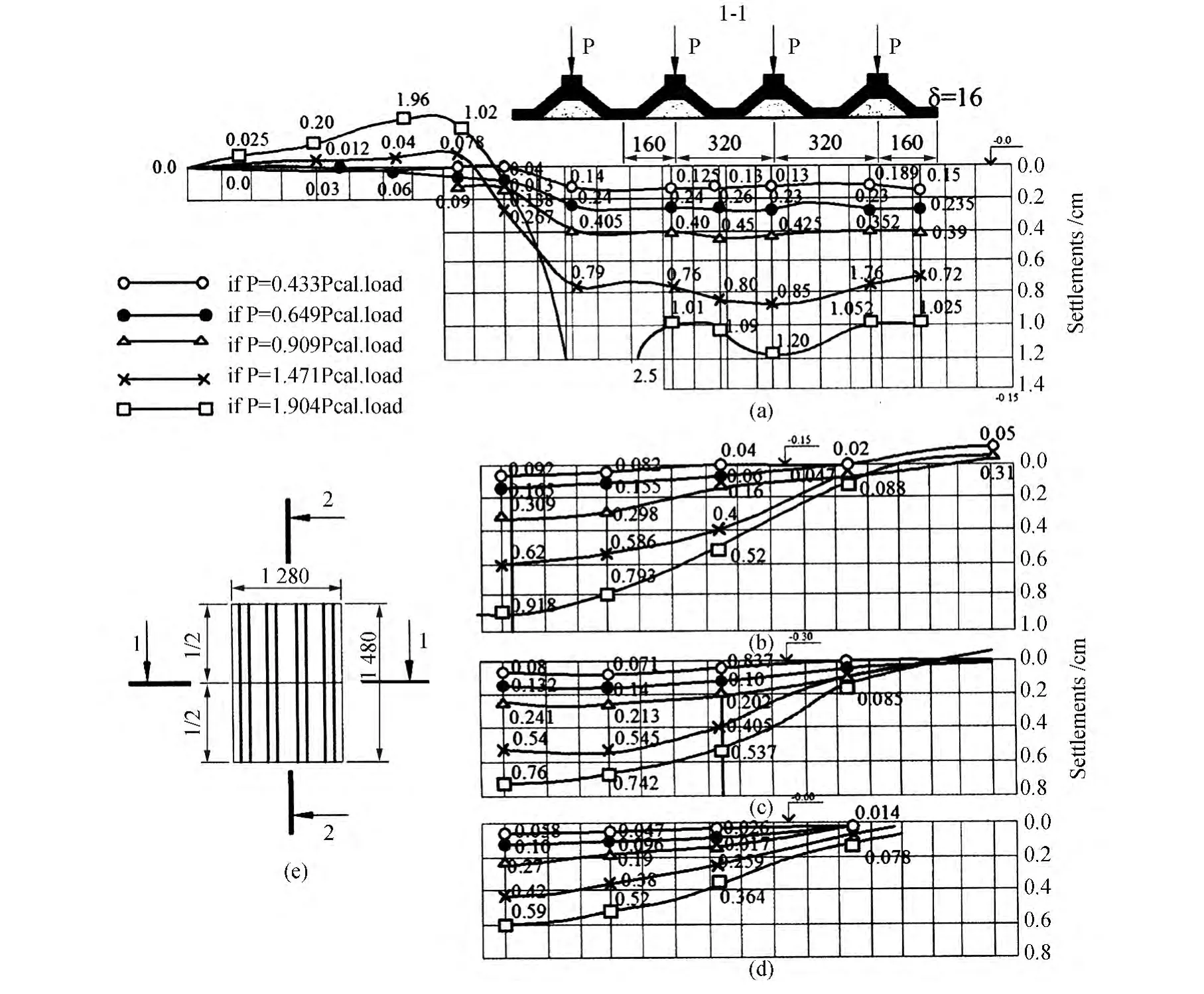
Fig.2 Deformation of the base in the cross section of model 1-1a-the zero-mark;b-at a depth of 15;c-the same,30;d-the same,60 cm;e-model plan
Within the compacting phases in the transverse direction of the foundation(Fig.2),which corresponds to the longitudinal direction of the building,the foundation settlement essentially takes place uniformly at a load within 1.5 P calculated load(P cal.load)The ground surface subsidence is simultaneously taking place outside the foundation with gradual decrease to the side from the foundation edges.The foundation settling down due to base compaction,entrains the ground lying outside the foundation model about 1/4 of its width.Maximum settlement of the ground is observed at the foundation edges.Under the action of the design load the settlement in the middle part of the foundation model is less than that of maximum settlement:in the transverse direction-by 15%,in the longitudinal direction-by 50%.The settlement of the foundation edges in the longitudinal direction(Fig.3)only was exceeded by 37%the settlement of middle part of the foundation model under a load of 1.5 P cal.load.
The settlement in the middle part exceeded by 6 %the settlement in the foundation edges in the transverse direction(Fig.2~3).

Fig.3 Base deformation in the longitudinal section 2-2a-the zero mark;b-at a depth of 15;c-the same,30;d-the same 60 cm;f-model plan and the measuring points of the settlement
The further course of load increase showed the increasing settlement in the transverse direction of foundation model in the middle part and decrease in the foundation edges.A similar dependence was observed in the longitudinal section 2-2.Thus,it can be concluded that within the first deformation phase the foundation settlement takes place uniformly with some excess to the foundation edge.
At the beginning of the formation of the second phase of the base deformation(under 1.5 P cal.load of and above),the evenness of the settlements is disturbed which can be clearly traced on the diagrams of the ground surface settlement under the footing of the foundation model shown in the Fig.2 and 3.
The surface and deep marks were lifted under 2.1 P cal.load,that is the second rebound phase of the deformation came;there came a sharp rebound around the foundation model in the transverse direction under the 4,4 P cal.load.
A settlement analysis of deep marks(Fig.2-3) showed the tensile deformations of the material,modeling the work of the natural structure of the shell-type foundation prevailed under the base in whole depth.
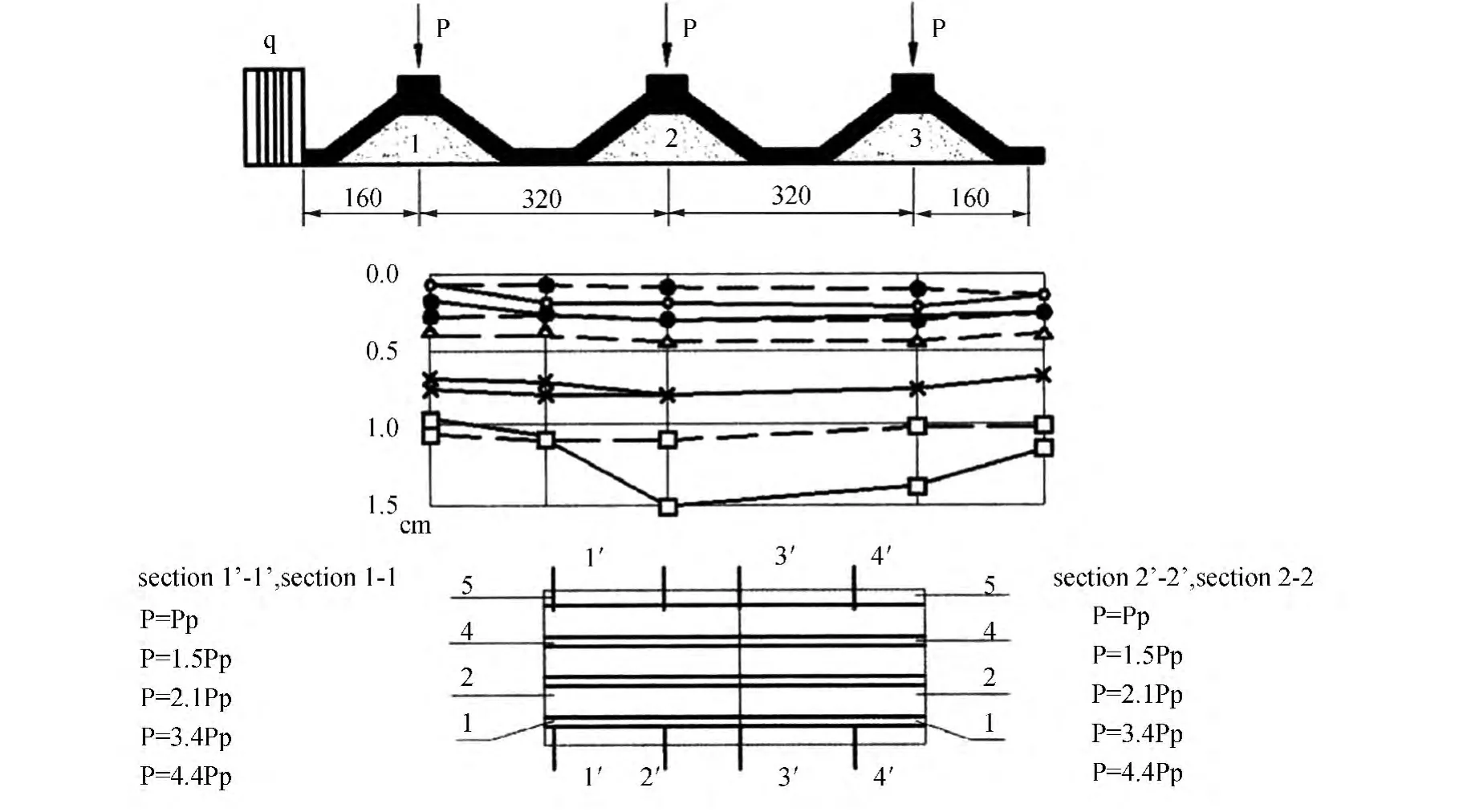
Fig.4 The cross-sectional deflection diagram of the shell-type foundation model---Cross section 1'-1';----cross section 2'-2'.Slabs are not shown
Under the load exceeds 1.5 P cal.load that corresponds to the formation beginning of a second phase of base deformation the resistive-strain sensors fixed exceeding of tensile pressures in the material of the model,in other words it corresponds to the beginning of micro-crack formation.Under the load of 2.1 P cal.load,macrocracks were formed that extended with the further load and led to brittle failure of foundation model structure.The above said is clearly seen by the character of cracks model shown in Fig.5a.
Deformation character of shell-type foundation model structure interrelates with base deformation.A moment of formation of phase shifting corresponds to the beginning of cracks formation in the structure elements,and the completion of phase shifting-their significant disclosure.
The third phase-the phase of rebound-leads to a complete loss of foundation strength.The above is clearly seen by the character of structure cracks shown in Fig.5a.
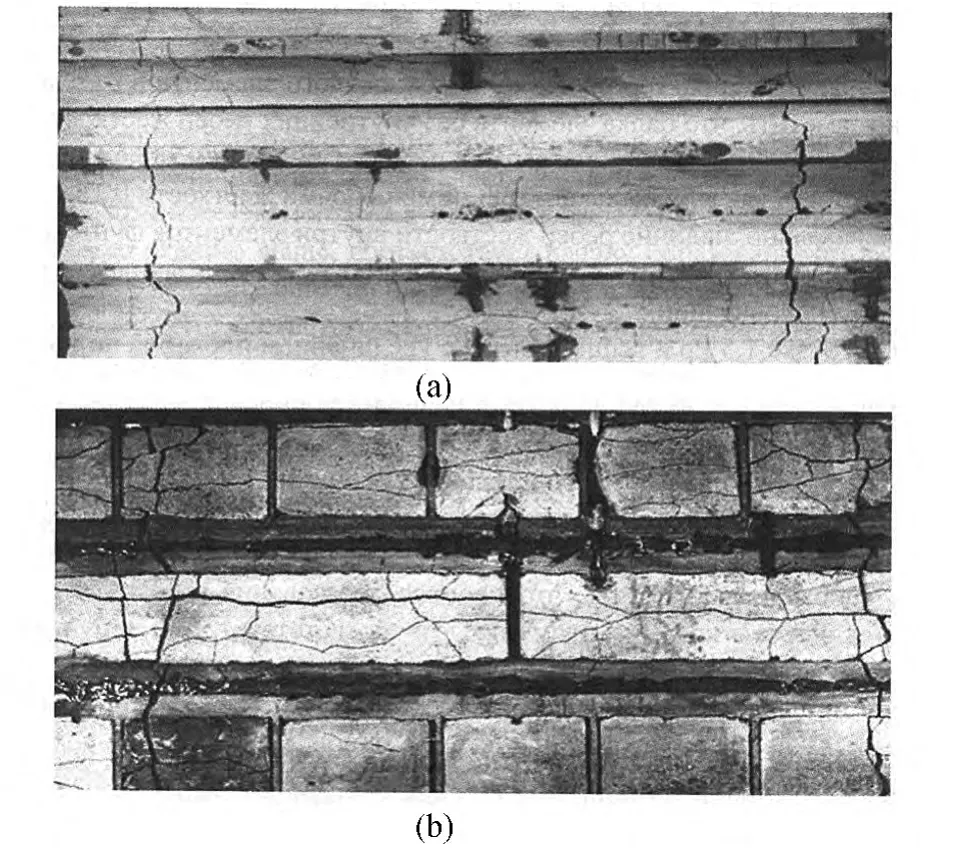
Fig.5 The fracture behavior of concrete model with floor slabsa-top surface;b-bottom surface;1-reinforcing stiffening ribs;2-sand-cement inserts
Taking into account the quantities of relative deformations of the upper and lower model elements fibers bending moments and normal forces were calculated.The greatest efforts basically arise in the breaking points of the shell-type foundation model and are reduced in the middle part of the inclined plates.At that the difference in efforts is insignificant within the load of 1.5 P cal.load.
One can judge about the work character of the floor slabs and reinforcing stiffening ribs only by crackformation because they lacked the resistive-strain sensors.
我查了一下地图,眉山在成都至乐山的交通要道上,距离成都只有78公里。其中的象耳山,就在眉山近郊。即便李白那个时代,也不至于连一根针都买不到。再说,一个农村老太,随便就能找到一根铁杵,说明这个地方的工业,还是比较发达。
Visual inspection of the stiffening ribs after the destruction of the model showed that they were under the tensile stresses.The maximum stresses occurred at the bottom of the ribs this fact is proved by the cracks going from the bottom upwards with a maximum opening at the bottom of the ribs(Fig.5b).It can be concluded that the stiffening ribs run in tension,that is they prevent displacement of the elements inclined plates and provide invariability of the shell-type foundation in its longitudinal direction.
The bending slabs character completely corresponds to bending model of the shell-type foundation in its transverse section(Fig.4)where the maximum deflection of the model corresponds to its middle part.The break character of the plates in the brittle failure of model structure testifies to the fact that bending plates in the longitudinal direction prevailed over transverse one.The scabbings of plate angles occurred in the places of their fastening to the model.
In order to study the qualitative picture of the stress state of reinforcing stiffening ribs and floor slabs of shell-type foundation model research on technology procedure[1]has been conducted.The research was conducted with the models made of optically active material based on epoxy resin ЭД-16M,hardened by maleic anhydride with the simulation of complete geometric similarity and was implemented by the stresses“freezing”.The picture of bands shown in Fig.6 characterizes the stress state of the elements of shell-type foundation model.
Fig.6 shows the bands picture of reinforcing ribs of a special model;parallelism of the bands characterizes the distribution of tensile stresses.
To identify the differences in the work of shelltype foundation depending on the availability of floor slabs and the fastening method;the foundation plane model was loaded without floor slabs,and then they were glued to the model.
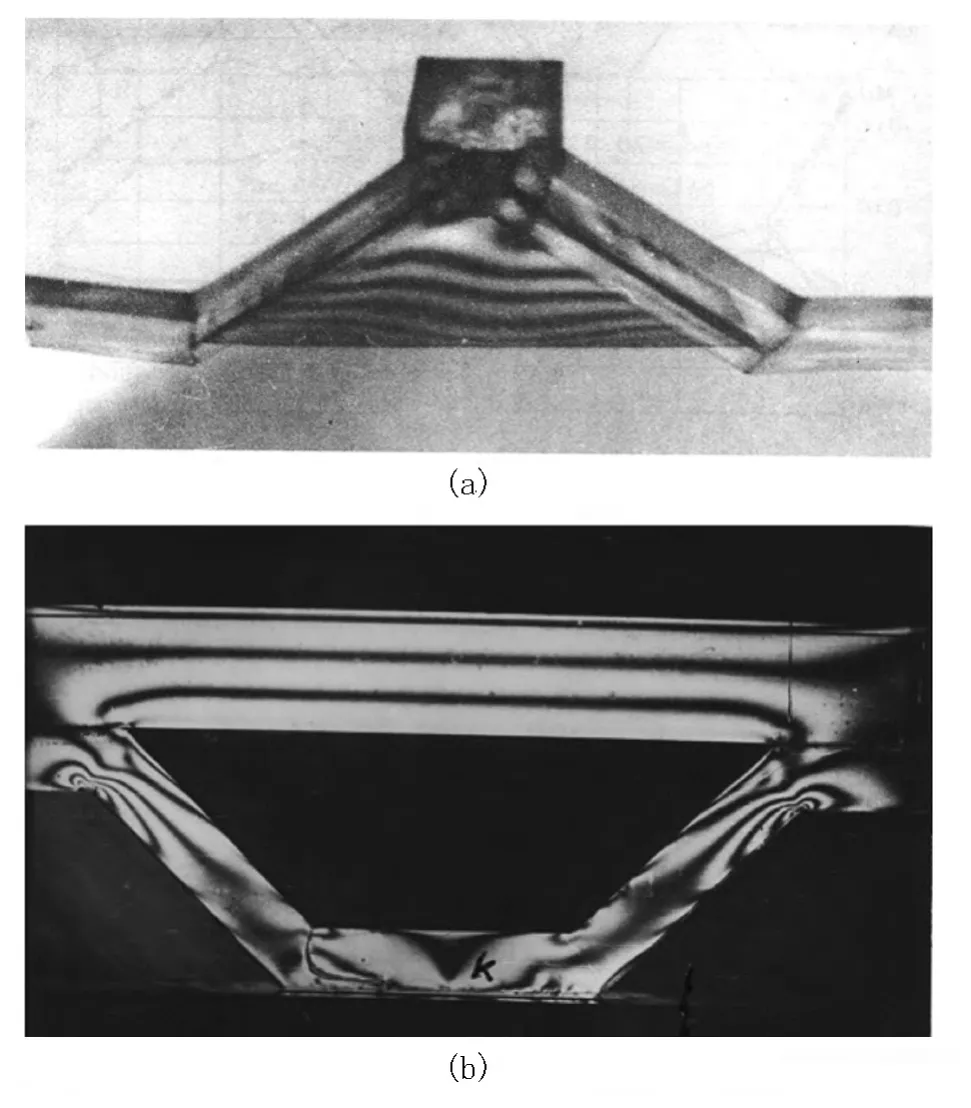
Fig.6 The picture of the bands in the model elements of the shell-type foundationa-in the stiffening ribs;b-in the floor slab
Fig.6b shows the bands picture of one out of three elements included in the model composition.The bands picture analysis gave detailed information about the qualitative nature of the stress state of the shelltype foundation model depending on the load acting on the model and fastening method of floor slabs with their free support and their fastening in the corners of the plates.
Bands picture in the floor slabs(their parallelism)characterize the tensile stresses in their plane and also the stress concentration in places of their fastening to the model that led to plates angles scabbing in the test of concrete model of shell-type foundation.Bands picture in the inclined elements shows the presence of tensile and compressive stresses.The stress concentration takes place(point《k》Fig.6b)in the middle part of horizontal plates resting on the foundation soil.
Photo-elastic research of plane model of shell-type foundation showed that the bridging significantly reduced the bending moment in section“k”in almost all relationships between the external loads.Analysis of the conditions of fastening slabs to shell-type foundation model showed that the transition from cramping to marker attachment of plates insignificantly changed the magnitudes of the bending moments and they differed by 10% ~20%.
Investigations of a building model in 1∶20 scale were carried out to study the SSS structures of the shell-type foundation considering up-foundational structure.
The distribution character and magnitude of the efforts in structures of the shell-type foundation consisting of 8 elements and its deformed state,working with ground structures were investigated usingmodels.(Fig.7).
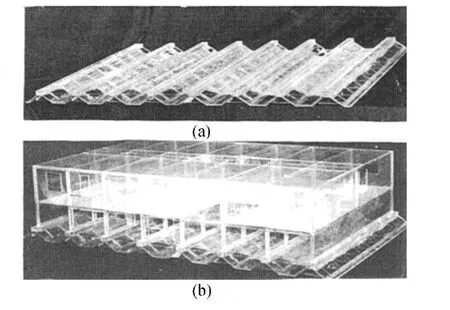
Fig.7 Foundation model(a)and structure with foundation(b)
At the first stage of research,floor slabs were fastened at the 4 corners;at the second stage they were fastened along the full length of their support on the beams of shell-type foundation.
In accordance with the objectives of the research it is sufficient to limit ourselves at the elastic work stage of the shell-type foundation,whereby the base can be considered as elastic running.Modeling was based on simple similarity.
According to research program,shell-type foundation model tests were planned to perform together with the building.However,as the building is not the object of investigation,we can consider only the model of the foundation building.The model of building fragment was adopted,consisting of a technical floor and one residential floor.For the model manufacture the plexiglass of the brand COЛ-95 with the elastic modulus E=2.95×103MPa was taken.
Fig.8 shows settlement diagrams of foundation cross-sections along the axes of at the deformation modulus of base model building fragment E0m = 11.5 MPa.

Fig.8 Researches results of the fragment of building model of shell-type foundation:a-settlements diagrams E0m=11.5 MPa:1 along the axis 1;2-along the axis 2;3-along the axis 3;4-along the axis 4;b-foundation drawing;c-bending moment diagram depending on E0m:1-at 2.08;2–at 4.54;3–at 9.0;4-at 11.5 MPa
In general,along all sections at different E0m insignificant settlements increase is typical and at the edges of building model in the longitudinal direction.At that quality settlement pictures of the same named beams(along the axes 1-4)are independent of E0m and low-mashed between themselves.Some increase of settlements to the center of the building was observed in the longitudinal direction along the full length of the shell-type foundation but mostly they were uniform.Thus,in joint operation of building,shell-type foundation,floor slabs and reinforcing stiffening ribs,the rigidity of the latter is significantly increased,that leads to leveling of settlements in the area of the building.
A correlation analysis showing that the deformation modulus of the base does not have an effect on the efforts in the shell-type foundation model elements was conducted to determine the closeness of the connection between E0m and efforts in the shell-type foundation model elements.(Fig.8d)
Analysis of research results also showed that in the stiffening ribs the tensile strains operate,except for 4-axis,where efforts are compressing E0m =9.0 and 11.5 MPa.Absolute values of normal forces decrease with increasing E0m.
Floor slabs mainly bear the tensile stresses besides the plates bear the bending moments of the same sign.
Analysis of efforts in the floor slabs,depending on the method of their fastening,showed that the presence of the complete fastening of the floor slabs led to reducing the magnitude of the bending moments and increase of the normal forces.
Fastening method of the floor slabs on beams of the shell-type foundation elements affected the efforts in the reinforcing stiffening ribs.The availability of complete fastening of slabs led to equalization of the efforts values in the reinforcing stiffening ribs and to the significant(about 1.4 times)decrease their efforts.
However,based on labor costs reduction at the construction site(in welding production of embedded details and embedment in place of their joints),the preference should be given to incomplete fastening of the floor slabs,in other words at the corners of slabs.The efforts in the horizontal beams of shell-type foundation are in favour of non-continuous fastening slabs.In particular,this affected the values of normal forces.Thus while the normal compressive forces took place in the model(where the slabs were fastened in the corners),only stretching took place in the model(with stiffening fastening slabs).The values of tensile forces significantly have increased.
From what has been said,it can be concluded that research results of the shell-type foundation model made with the help of a photoelasticity method on the impact of floor slabs on the efforts in the foundation elements,prove the results discussed above.
Research results served as the foundation for the design of experimental buildings in Igarka.
3 Conclusions
1)The shell-type foundations have the sufficient strength,rigidity and provide the reliability of buildings in the presence of high-temperature strongly-icy ground at the base.
2)The intermediate layer greatly reduces the cryogenic processes during the freezing and thawing and also prevents the foundation material from its moistening due to the migration of moisture to the freezing front and,moreover,due to filtration of atmospheric precipitation as well as it posesses a large filtration coefficient.
3)The application of the shell-type foundations with the developed surface of bearing coupled with the intermediate layer reduces the unit pressure,and accordingly,the tension in the underlying ground.
4)Decrease temperature of ground base and raising the upper limit of permafrost soil are occurred for the building construction at the permafrost soil using ventilated shell-type foundation.
5)Shell-type foundations can be used at the taliks with significant compressibility“Goncharov,2006”.
6)The disturbance of temperature condition of ground base and disturbance of environment do not occur in the construction at the permafrost soil.
7)The application of the shell-type foundations in modern construction in the permafrost zone is actual from an economic and ecological point of view;it does not require time-consuming and costly works in construction of pile foundations in structurally weak soils,including taliks,icy and others.
[1] Stelmach S I,Handukov G K.Recommendations for reinforcedconcrete spatial structures research.II spatial structures of buildings and constructions[M].1972,(1):165-170.
[2] Tarasyuk V G.Sharapov G V.Methodological recommendations for modeling the ground base with investigation of the stress strain state of building[M].Kiev:Publisher NIISK.1981.
[3] Yarmulnik F V,Sharapov G V,Gaydukt V G.The technique of maching material with investigation of reinforced concrete structures in the models[M].Kiev:Graduate School.1974.
[4] Goncharov Y M.Effective structure of foundations in permafrost soil[M].Novosibirsk:science.Siberian department.1988.191-198.
[5] Goncharov Y M.Construction experience of the buildings in the watered taliks[M].Yakutsk:Science and Technology in Yakutia.2006,1(10):12-16.
猜你喜欢
杂志排行
黑龙江大学工程学报的其它文章
- The harm of perennial frozen soil to the pipeline exporting the crude oil from Mohe county to Daqing city
- Overview of research methods of frozen soil hydrology in Heilongjiang Province
- Environmental geochemistry of urban areas in Yakutia
- A permafrost factor in the development of deformations on the Amur Highway
- The problem of project statement of construction principles of buildings and facilities in permafrost
- The forecast of a temperature regime of soils containing the pile foundation of a pithead on diamond-mining mines of cryolithic zone
